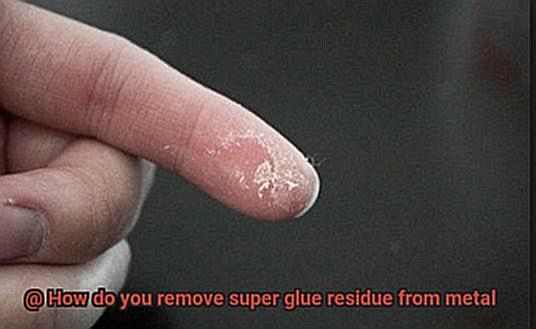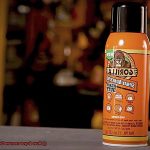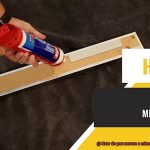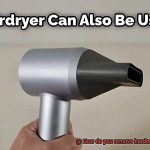No worries, we’ve got your back. Whether it’s a messy mishap or an accidental spill, dealing with super glue residue can be a real headache. But fear not, because today we’re about to unveil the secrets to banishing this sticky nuisance from metal.
Picture this: You just finished assembling a stunning metal sculpture, only to discover that the excess super glue has left behind an ugly residue. It’s like an adhesive monster has invaded your masterpiece. But before you panic and think about tossing it in the trash, let us show you some simple yet effective techniques to save the day.
In this blog post, we’ll spill the beans on tried and tested methods for removing super glue residue from metal. We’ll explore a range of household ingredients and expert tips that will bring back the former glory of your metal surfaces. From acetone and nail polish remover to the power duo of baking soda and vinegar, we’ll uncover the best solutions for different types of metal.
So whether it’s a sleek stainless steel kitchen appliance, a creative metal craft project, or even a cherished piece of jewelry, we’re here to be your guiding light towards a glue-free, gleaming metal finish. Say goodbye to that sticky mess and prepare yourself for reclaiming the natural shine of your precious metals.
Stay tuned for upcoming sections as we dive deep into the world of removing super glue residue from metal. Get ready to discover ultimate solutions and bid farewell to those sticky nightmares.
What is Super Glue?
Contents
- 1 What is Super Glue?
- 2 Common Methods for Removing Super Glue Residue from Metal
- 3 Using Acetone to Remove Super Glue Residue
- 4 Using Isopropyl Alcohol to Remove Super Glue Residue
- 5 Using Warm Soapy Water to Remove Super Glue Residue
- 6 Using Abrasive Methods to Remove Super Glue Residue
- 7 Using Commercial Adhesive Removers to Remove Super Glue Residue
- 8 Tips and Precautions for Removing Super Glue Residues from Metal
- 9 Conclusion
Unlocking a world of possibilities, Super Glue, also known as cyanoacrylate adhesive, has forever changed the way we bond materials together. Developed in the 1940s and perfected in the 1950s, this fast-acting adhesive has become an indispensable tool in both industrial and household settings. In this article, we will delve into the captivating realm of Super Glue, exploring its composition, mesmerizing properties, and its exceptional ability to create unbreakable bonds with metal.
What is Super Glue?
Super Glue can be likened to a liquid magician – a transparent elixir that defies gravity and binds with astonishing strength. Composed primarily of cyanoacrylate, an acrylic resin, this adhesive undergoes a magical transformation when it encounters moisture. This miraculous reaction, known as polymerization, instantly transforms the liquid resin into a solid state, resulting in an unyielding bond between materials.
Properties and Benefits:
- Quick-drying Marvel: Super Glue’s nimble nature enables it to traverse the tiniest crevices and fractures, swiftly sealing them shut.
- Mighty Bonding Strength: Armed with unparalleled power, Super Glue creates connections that surpass the strength of the very materials it binds together. This extraordinary characteristic makes it an ideal choice for fortifying metal objects against relentless stress and pressure.
- Versatility Personified: Super Glue’s talents extend far beyond metal bonding. It eagerly embraces other materials such as plastic, wood, ceramics, and more.
- User-friendly Wizardry: Whether you’re a seasoned professional or a fledgling DIY enthusiast, Super Glue welcomes all with open arms. Its simplicity and ease of use empower individuals from all walks of life to effortlessly tackle industrial projects or mend household treasures.
Common Methods for Removing Super Glue Residue from Metal
Super glue has an uncanny ability to stick to anything, including metal surfaces. But fear not. As an expert in the field, I’m here to reveal some tried and true methods that will help you bid farewell to that stubborn super glue residue. So, gear up and get ready to discover the enchanting secrets of removing super glue from metal surfaces.
Acetone – The Mighty Solvent:
In the battle against super glue residue on metal, acetone stands as a mighty solvent. Its powerful properties can break down the adhesive bond, making removal a breeze. To wield this method, apply a small amount of acetone to a cotton ball or cloth and gently rub the affected area. But remember, safety first. Don your gloves and work in a well-ventilated space to protect your skin from this potent solvent. Repeat this process until every trace of residue is vanquished.
Nail Polish Remover – The Secret Weapon:
Did you know that nail polish remover holds a secret power against super glue residue? Yes, indeed. With its main ingredient being acetone, it can be your trusted secret weapon in this battle. Apply a small amount of nail polish remover to a cotton ball or cloth and gently rub the affected area. However, exercise caution when using it on colored or painted metal surfaces, as it may cause discoloration or damage.
Warm Soapy Water – The Gentle Touch:
Sometimes, all you need is a touch of gentleness to conquer super glue residue. Prepare for the battle by filling a bowl or sink with warm water and a few drops of dish soap. Immerse the metal object in this soothing concoction for several minutes to soften the glue’s grip. Then, armed with a soft cloth or sponge, gently scrub away the residue. Rinse the metal thoroughly with clean water and dry it completely.
Rubbing Alcohol – Dissolving the Bond:
When facing a formidable foe like super glue residue on metal, rubbing alcohol can be a powerful ally. Moisten a cotton ball or cloth with this liquid warrior and gently rub the affected area. Witness how the alcohol dissolves and lifts the adhesive, making it easier to remove. But remember, ventilation is crucial, and prolonged exposure to rubbing alcohol should be avoided.
Using Acetone to Remove Super Glue Residue
Picture this – a stunning metal surface marred by the stubborn remnants of super glue. But fret not. With the secret weapon known as acetone, you can bid farewell to that unsightly residue and restore your metal surfaces to their former glory. In this comprehensive guide, we will delve into the fascinating world of using acetone to remove super glue residue from metal surfaces, leaving no trace behind.
Harnessing the Mighty Acetone:
Prepare to be amazed by the remarkable powers of acetone. This incredibly potent chemical acts as a superhero, dissolving the unyielding bonds of super glue with ease. By breaking down the adhesive, acetone simplifies the process of removing residue from your cherished metal surfaces. However, exercise caution before diving in – it’s essential to ensure that your metal surface can withstand the power of acetone. Metals like aluminum and brass may react negatively, potentially causing damage.

Unearthing the Elixir:
Fear not, for the magical elixir known as acetone is easily accessible at your local hardware store or beauty supply emporium. You can also find this wondrous substance nestled within nail polish removers. Before embarking on your journey to eliminate super glue residue, make sure you have an ample supply of acetone on hand.
The Dance of Removal:
- Gather your tools: Arm yourself with a clean cloth or cotton ball, lightly saturated with acetone.
- A gentle touch: Apply delicate pressure as you glide the cloth or cotton ball over the stubborn super glue residue. Be mindful not to scrub too vigorously, as you don’t want to leave behind any unsightly scratches on the metal surface.
- Persistence is key: Continue the rhythmic motion until you witness the super glue residue surrendering, softening, and dissolving before your very eyes. Depending on the thickness of the residue, a touch of patience may be required.
- Erasing the evidence: Once the residue succumbs to the power of acetone, take a fresh cloth or cotton ball and wipe away the dissolved glue. Repeat this process as many times as necessary until every last trace of residue vanishes.
Using Isopropyl Alcohol to Remove Super Glue Residue
In the realm of do-it-yourself solutions, a true superhero emerges – isopropyl alcohol, also known as rubbing alcohol. With its remarkable ability to dissolve and eliminate dried glue, this common household solvent is your ultimate ally in the fight against sticky situations. So, don your cape and prepare to delve into the world of using isopropyl alcohol to banish super glue residue from metal surfaces.
The Mighty Isopropyl Alcohol:
Possessing extraordinary powers, isopropyl alcohol reigns supreme when it comes to combating super glue residue on metal surfaces. Its rapid evaporation rate ensures effortless dissolution and removal of even the most obstinate dried glue. But how can you harness this mighty solvent? Let us embark on a step-by-step journey through the process:
Step 1: Gather Your Arsenal:
To embark on this mission, arm yourself with a clean cloth or sponge and a small amount of isopropyl alcohol. Ensure that your cloth or sponge is slightly damp, but not dripping wet.
Step 2: Prepare for Battle:

Distribute the isopropyl alcohol evenly across your cloth or sponge, ensuring thorough saturation. Now, you are fully equipped to combat those pesky super glue residues.
Step 3: Rub It Out:
Engage in gentle yet firm rubbing of the affected area with your cloth or sponge. Apply slight pressure and witness the isopropyl alcohol’s magical prowess as it dissolves the super glue residue. Continue rubbing until the residue starts lifting off the metal surface.
Step 4: Persistence Pays Off:
In the face of particularly stubborn glue residues, do not falter. Grant the isopropyl alcohol a few minutes to work its magic. Allow it to penetrate and loosen the glue by letting it rest on the affected area. This additional step could be the key to achieving a flawlessly restored finish.
Step 5: Rinse and Revitalize:
Triumphantly having removed the residue, it is time for the final flourish. Rinse the metal surface with water, ensuring the complete removal of any remaining isopropyl alcohol and residue. Employ a clean cloth to thoroughly dry the surface, unveiling its renewed splendor.
Using Warm Soapy Water to Remove Super Glue Residue
Prepare to embark on a journey that will liberate your metal surfaces from the clutches of stubborn super glue residue. Whether it’s a crafting catastrophe or an accidental adhesive mishap, fear not. I am here to reveal the secret to effortlessly vanquishing super glue remnants from your beloved metal objects. Brace yourself for the magnificent power of warm soapy water.
Why Warm Soapy Water?
The secret lies in the extraordinary properties of warm soapy water. This dynamic duo possesses the ability to loosen the tenacious grip of super glue, rendering it vulnerable and easily removable. The warmth and soapy embrace work in harmony, breathing new life into your cherished metal possessions.
The Step-by-Step Guide:
Prepare to embark on a transformative journey as we unveil the simple yet potent process of using warm soapy water to eradicate super glue residue from metal surfaces. Buckle up and follow these steps:
Crafting the Perfect Potion:
Begin by filling a bowl or sink with comfortably warm water, ensuring it’s not scalding hot. Now, add a few drops of trusty dish soap and gently mix until a delightful soapy solution forms. This magical concoction is now ready to work its wonders.
Immerse and Unwind:
Dip the metal object burdened with super glue residue into the warm soapy water, allowing it to bask in the solution’s restorative embrace for approximately 15-30 minutes. During this tranquil soak, the soap will tirelessly wage war against the insidious glue.
Gentle Scrubs and Whispers:
Once the soak has completed its transformative dance, take a soft cloth or sponge and tenderly scrub the affected area. Witness as the warm soapy water continues its enchantment, coaxing the glue to relinquish its grip. For any tenacious remnants, employ the aid of a plastic scraper or your nimble fingernail. Exercise caution, ensuring the metal surface remains unblemished.
Rinse and Repeat:
With your scrubbing efforts complete, rinse the metal object thoroughly with clean water, bidding adieu to any lingering traces of soap. This final flourish guarantees a flawless finish that will dazzle the eye and restore your metal treasure to its former glory. Revel in the satisfaction of a job well done.
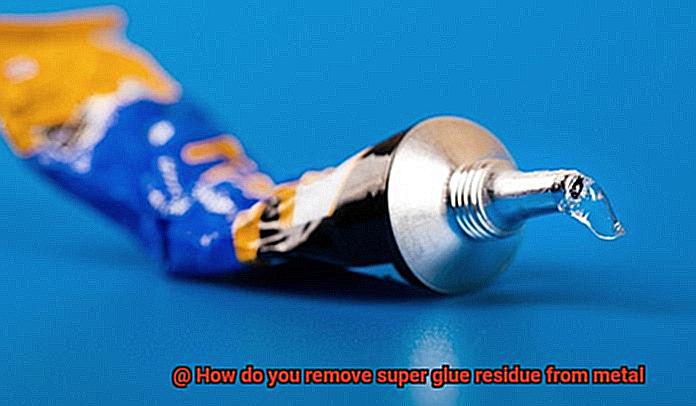
Using Abrasive Methods to Remove Super Glue Residue
Fed up with the unsightly super glue residue tarnishing your beloved metal surfaces? Fear not, my friends, for I am here to introduce you to the exhilarating world of abrasive methods. Brace yourselves as we embark on an adventure like no other, armed with sandpaper, plastic scrapers, and wire brushes.
First on our list is the tried-and-true sanding technique. Envision yourself gently rubbing the affected area with fine-grit sandpaper or an abrasive tool. With each stroke, the stubborn glue residue gradually succumbs to the relentless force, unveiling the pristine beauty of your metal surface.
But wait, there’s more. Behold the art of scraping. Armed with a plastic scraper or razor blade, you can meticulously scrape away the clingy remnants of super glue from your metal surface. But beware, my comrades, a steady hand is required to avoid leaving behind any unwanted scratches. Opt for a plastic scraper for a smoother and safer scraping experience.
For those truly tenacious glue residues that refuse to surrender, fear not. The wire brush comes to our rescue. Its bristles act as warriors against the adhesive invaders, vigorously scrubbing them off the metal surface. However, exercise caution and wield your brush with finesse to avoid unintentional scratches or damage.
But what if these methods still fall short of victory? Fret not, my intrepid explorers, for we have an ace up our sleeves – abrasive compounds or cleaners. These potent allies contain fine particles that break down and conquer even the most stubborn glue residues. But remember to heed the instructions provided by the manufacturer and conduct a small test on an inconspicuous area before unleashing their power upon your metal surface.
As we embark on this thrilling abrasive journey, remember to proceed with care and precision. Slowly and gently apply just enough pressure to achieve success without leaving any battle scars on your beloved metal. Once the super glue residue has been vanquished, cleanse the surface with a mild soap and water solution to eradicate any remnants of the abrasive process.
But heed my warning, dear comrades, for not all metals are forged equal. Delicate finishes or metals like aluminum may be more susceptible to damage from our abrasive techniques. In such cases, it is wise to seek professional assistance or explore alternative methods to ensure the safety and preservation of your cherished metal possessions.
Using Commercial Adhesive Removers to Remove Super Glue Residue
We’ve all experienced that heart-sinking moment when super glue residue stubbornly clings to our beloved metal surfaces. But fear not. The answer lies within the enchanting realm of commercial adhesive removers. In this captivating guide, we will delve into the art of using these magical elixirs to conquer the unyielding grip of super glue residue from your precious metals. Get ready to unleash the full potential of commercial adhesive removers and bid farewell to those sticky remnants.
Choosing the Perfect Potion:
Commercial adhesive removers are specifically crafted to tackle even the most resistant adhesives, including super glue residue on metal surfaces. Select a remover suitable for use on metal and always heed the instructions provided by the manufacturer for optimal results.
Setting the Stage:
Before embarking on this transformative journey, prepare both yourself and your workspace. Protect your hands by wearing gloves, shielding them from any potential harsh chemicals present in the adhesive remover. Ensure proper air circulation by working in a well-ventilated area.
The Dance of Application:
Now it’s time to witness the true power of adhesive removers. Begin by applying a small amount onto a clean cloth or sponge. With gentle strokes, caress the affected area, ensuring every inch of super glue residue is enveloped in the remover’s embrace.
Unleashing Sorcery:
Grant the adhesive remover its rightful time to work its magic. Allow it to sit on the surface for a few precious minutes, granting it ample opportunity to penetrate and dismantle the glue’s hold. Remember, each product may have its own recommended waiting period, so consult the instructions as your guide.
The Sweet Taste of Victory:
Once you have patiently allowed the adhesive remover to accomplish its mission, take a fresh cloth or sponge and wipe away the dissolved glue and remnants of the remover from the surface. Behold the remarkable progress you’ve made. Should traces of super glue residue persist, repeat the process until triumph is achieved.
Conquering the Stubborn Few:
In rare instances, certain super glue residues may prove to be formidable adversaries, particularly if they are thick or exceptionally stubborn. In such cases, you may need to launch multiple assaults using the adhesive remover, supplemented by gentle scraping using a plastic scraper or toothbrush. Exercise caution to prevent any unintentional harm to the metal surface.
Tips and Precautions for Removing Super Glue Residues from Metal
Removing super glue residues from metal can be a challenging task due to the strong adhesive properties of the glue. However, with the right tips and precautions, you can safely and effectively get rid of the sticky residues without causing any damage to the metal surface. In this article, we will discuss five important tips and precautions to follow when removing super glue residues from metal.
Test in an inconspicuous area:
Before attempting any method or solution to remove super glue residues from metal, it is essential to test it on a small, hidden area first. This will help you determine if the method or solution is safe to use and won’t cause any damage or discoloration to the metal surface. By conducting this test, you can avoid potential harm to your valuable metal items.
Protect surrounding areas:
When working with solvents or chemicals to remove super glue residues, it’s important to protect surrounding areas or surfaces that do not need treatment. Using masking tape or plastic sheets, cover and isolate the specific area where the glue residue needs to be removed. This precautionary measure will ensure that no unintentional damage occurs to other parts of the metal surface.
Use protective gloves and eyewear:
Some solvents or chemicals used for removing super glue residues can be harsh or toxic. To protect yourself from any accidental contact with these substances, it is highly recommended to wear protective gloves and eyewear. Your safety should always be a priority when handling potentially harmful chemicals.
Read and follow product instructions:
If you choose to use a commercial adhesive remover or solvent, it is crucial to read and follow the product instructions carefully. Different products may have specific application methods or safety precautions that need to be adhered to. By following these instructions, you can ensure effective removal of the super glue residues without causing any harm to the metal surface.
Start with gentle methods and gradually increase strength if needed:
It is always advisable to start with gentle methods when attempting to remove super glue residues from metal. Begin by using warm soapy water, rubbing alcohol, or acetone-free nail polish remover. Apply these substances using a soft cloth or sponge and gently rub the glue residue in circular motions.
If the gentle methods do not effectively remove the glue residue, you can gradually increase the strength of the solvent or abrasive being used. However, it is important to proceed with caution and follow the provided instructions to avoid damaging the metal surface.
xIEcdSG77os” >
Conclusion
Removing super glue residue from metal can be a pesky task, but fear not, there are effective methods to conquer this sticky situation.
One way to tackle the problem is by using acetone, a powerful solvent that breaks down the adhesive properties of super glue. Simply soak a cloth or cotton ball in acetone and gently rub it onto the affected area.
The glue should start to dissolve, allowing you to easily wipe it away. Another option is using isopropyl alcohol, which works similarly to acetone.
Apply it to a cloth and gently scrub the residue until it loosens and can be wiped off. If these solvents aren’t readily available, you can also try using nail polish remover containing acetone or even vinegar.
Remember to always test any solution on a small, inconspicuous area first to ensure it doesn’t damage the metal finish.

